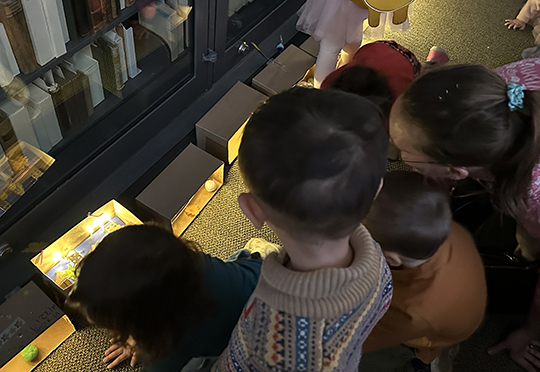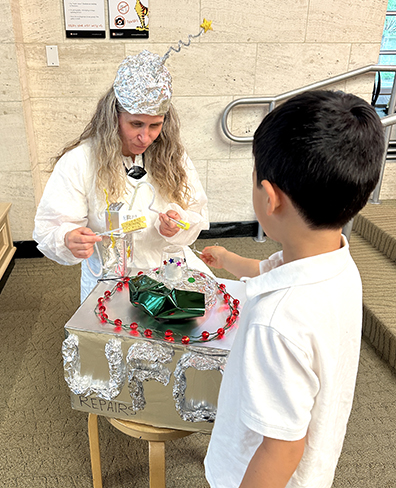 It’s a beautiful day in the galaxy, but if your spaceship’s hyperdrive starts to hyperdroop, bring it into our full service UFO repair station! We even clean windows!
It’s a beautiful day in the galaxy, but if your spaceship’s hyperdrive starts to hyperdroop, bring it into our full service UFO repair station! We even clean windows!
We read We Are Definitely Human by X. Fang (Tundra Books, 2024). When a giant crash startles Mr. Li from his bed, and he discovers three strangers who assure him they are DEFINITELY human. A kind man at heart, Mr. Li invites the strangers back to his house and offers to help them repair their ship…errr…car. Soon, the whole community is pitching in, and the strangers depart for further adventures feeling good about the humans of planet Earth.
This book is totally hilarious, with perfect comedic timing in both its text and illustrations. It was an absolute pleasure to read aloud – make sure to leave time for laugh breaks!
You’ll need:
- 2 sturdy paper plates
- 1 strip of poster board (approximately 1.5″ x 22″)
- 1 clear plastic drinking cup (I used a 2.75″ tall plastic cocktail glass)
- Flying saucer decorating materials (more on this below!)
- Scissors, stapler and tape for construction
- Markers for decorating
- Hot glue
The UFOs we crafted for this story time are almost identical to the zip line ships from this 2015 post (you’ll find the full instructions here). Basically, the UFO is two paper plates with a circlet of poster board between them, a plastic cup cockpit, and a lot of fun supplies (tin foil, embossed foil paper, sparkle stems, dot stickers, and some glitter stars).
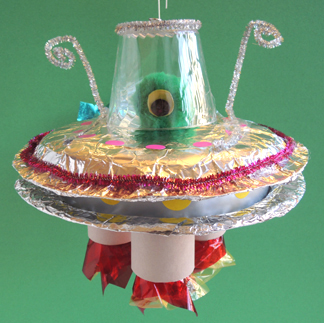
We did makes some modifications. We skipped the rocket boosters underneath this time, swapped the pom pom alien for a toilet paper tube alien, and replaced the paperclip on top of the cockpit with a loop of clear beading cord.
But the thing that really made this story time one of the best of the year so far? The UFO repair shop!
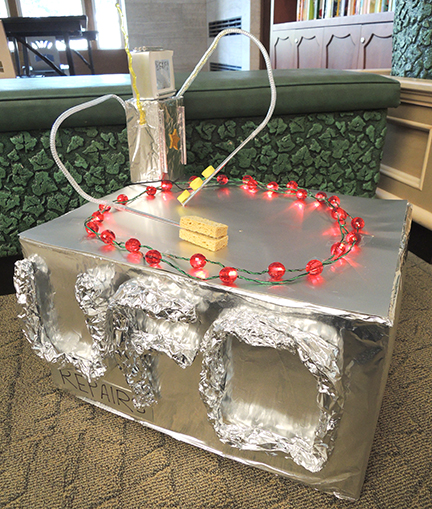 I’ve been working with kids for decades, and sometimes I forget how powerful a box, tin foil, strand of lights, mesh tubing, and drinking straws can be. That’s basically all I used to create this repair shop. But the reaction to the set up was so powerful – customers lined up for a solid 20 minutes, coming back repeatedly with new and unique problems their UFOs were experiencing. I would hand them them the repair “wands” and we would boop and bleep our way to fixing the engines.
I’ve been working with kids for decades, and sometimes I forget how powerful a box, tin foil, strand of lights, mesh tubing, and drinking straws can be. That’s basically all I used to create this repair shop. But the reaction to the set up was so powerful – customers lined up for a solid 20 minutes, coming back repeatedly with new and unique problems their UFOs were experiencing. I would hand them them the repair “wands” and we would boop and bleep our way to fixing the engines.
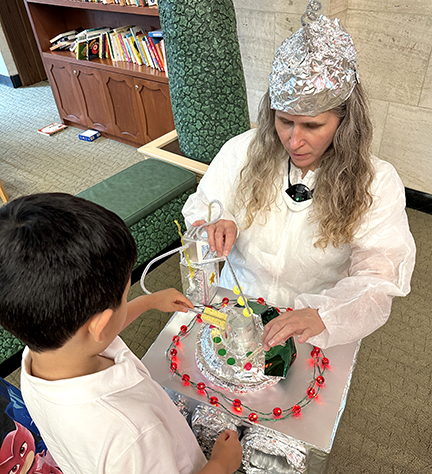
We also managed to do a bit of upcycling…you might recognize the strand of red lights from Katie’s awesome 2019 holiday creation, or the white coveralls from our story time stint as sanitation superstars.

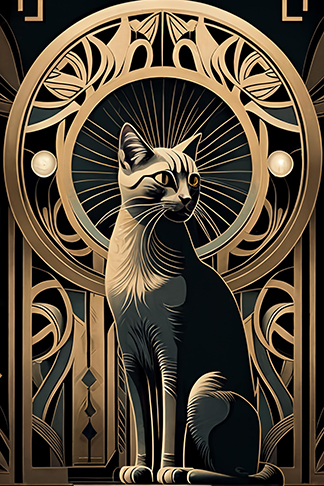 It’s the party to end all parties, old sport! To celebrate the 100th anniversary of the publication of “The Great Gatsby” this April,
It’s the party to end all parties, old sport! To celebrate the 100th anniversary of the publication of “The Great Gatsby” this April, 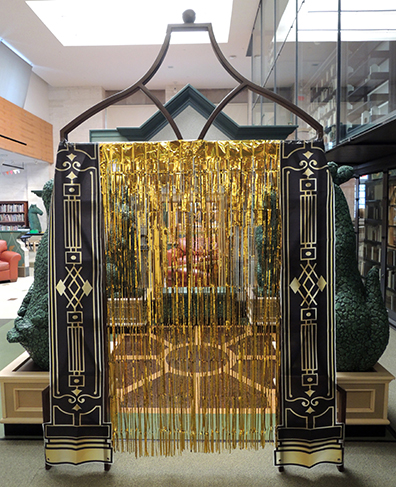 As some of you may have already guessed, the gold tinsel almost stole the entire show. Kids ran through it, swatted it, wore it as hair, and sat quietly with it tickling their faces. They also pulled it out in handfuls and threw it all over the gallery. It was a total mess after the event, and we’re still finding strands of tinsel in the library, but it was worth it!
As some of you may have already guessed, the gold tinsel almost stole the entire show. Kids ran through it, swatted it, wore it as hair, and sat quietly with it tickling their faces. They also pulled it out in handfuls and threw it all over the gallery. It was a total mess after the event, and we’re still finding strands of tinsel in the library, but it was worth it!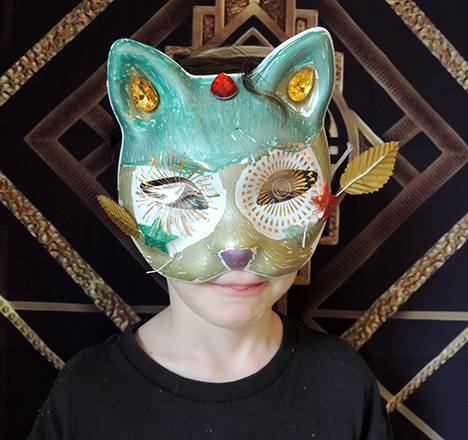 We also offered a smaller, more focused art activity elsewhere in the gallery – coloring sheets that featured the work of British artist Louis Wain, who was popular during the Gatsby era! Wain became famous for his drawings of cats depicted with human-like appearance and behavior, and we pulled images from our special collections to share with the community.
We also offered a smaller, more focused art activity elsewhere in the gallery – coloring sheets that featured the work of British artist Louis Wain, who was popular during the Gatsby era! Wain became famous for his drawings of cats depicted with human-like appearance and behavior, and we pulled images from our special collections to share with the community.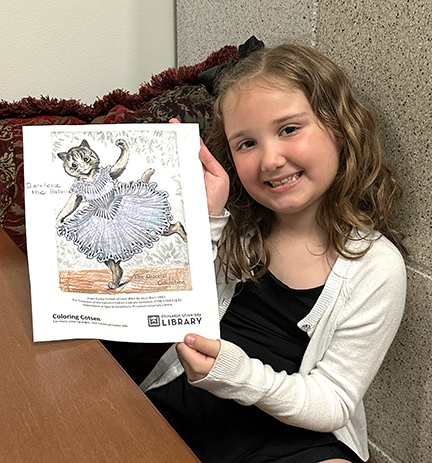
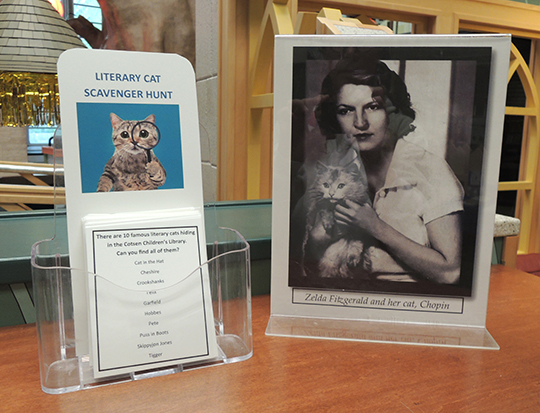
 Speaking of familiar cats, we thought it would be fun to ask library staff to submit portraits for a “Match the Librarian to Their Cat” game. Hint: staff wore their cat’s colors, and even hilariously replicated their poses and expressions.
Speaking of familiar cats, we thought it would be fun to ask library staff to submit portraits for a “Match the Librarian to Their Cat” game. Hint: staff wore their cat’s colors, and even hilariously replicated their poses and expressions. Our Great Catsby event was also a cat food drive to benefit
Our Great Catsby event was also a cat food drive to benefit 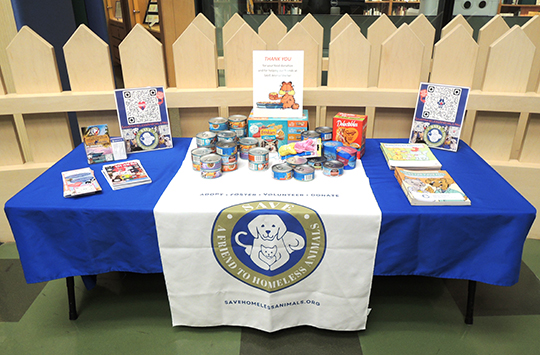
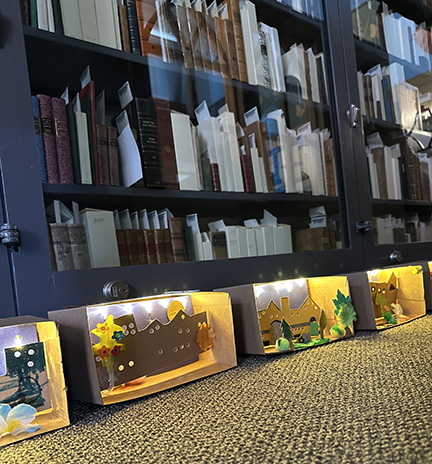
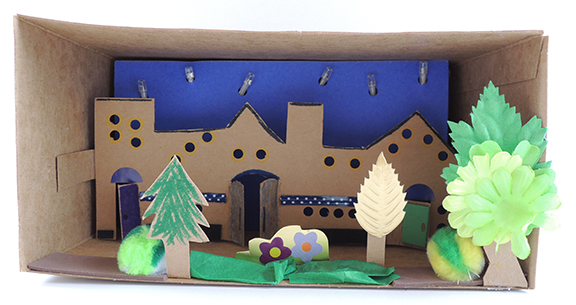
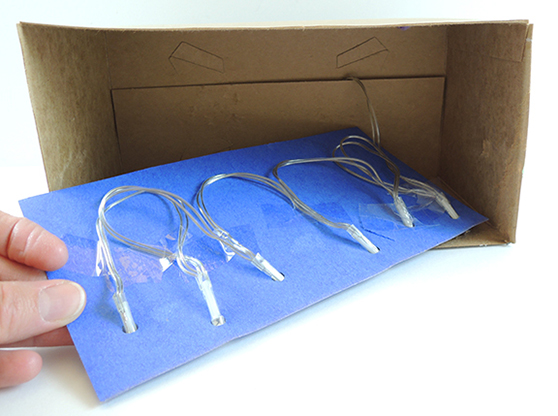 In the above photo, you can also see how the end of the light strand is threaded through the back of the box. It leads to the strand’s battery pack, which we taped to the back of the box to make it extra sturdy:
In the above photo, you can also see how the end of the light strand is threaded through the back of the box. It leads to the strand’s battery pack, which we taped to the back of the box to make it extra sturdy: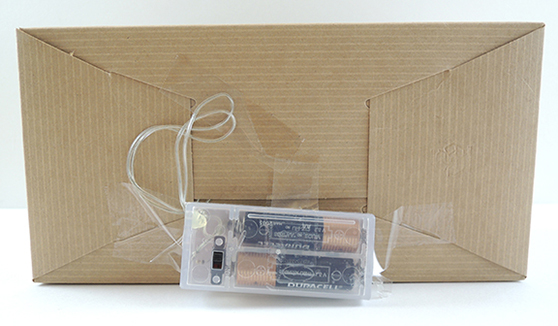
 When the projects were complete, we lined up all the boxes, turned out the lights, and everyone took a walk to enjoy and observe the little worlds we created!
When the projects were complete, we lined up all the boxes, turned out the lights, and everyone took a walk to enjoy and observe the little worlds we created!